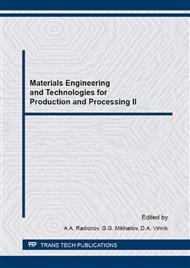p.3
p.8
p.13
p.20
p.26
p.31
p.34
p.40
p.46
Amorphous Copper-Based Alloys: Structure, Technology and Properties
Abstract:
The scientific interest in amorphous and nanocrystalline materials is associated with the expectation of different structural and size effects on the properties of solids, as applied attention due to the possibility of fundamental changes in the properties of polycrystalline materials. Numerous experimental studies indicate the following regularities: the higher the degree of equilibrium of the melt prior to crystallization is, the better quality has a solid metal. In industrial conditions the equilibrium state of the melt is achieved by the technology for heat treatment of the melt. The scientific rationale for this technology is the results of studying the temperature and time dependence of physical properties. The present work describes the analysis of the physical properties of liquid amorphous solder, conducted heat treatment of the melt and the study of the samples mechanical properties in the solid state. Amorphous ribbons obtained by the technology for melt heat treatment, ceteris paribus withstand higher loads in tension, exhibit better ductility and are characterized by high stability of the results. This fact confirms a more uniform material structure.
Info:
Periodical:
Pages:
26-30
Citation:
Online since:
September 2016
Authors:
Price:
Сopyright:
© 2016 Trans Tech Publications Ltd. All Rights Reserved
Share:
Citation:


